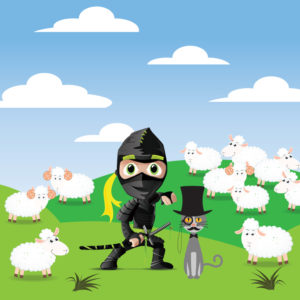Questions for a Language Ninja: Is a Lamb a Who, a That, or a Chop?
Welcome to the first Language Ninja article of what is sure to be a blazing hot summer!
Ninja’s beat the heat tip: Switch out your heat-absorbing black shinobi shōzoku for a light-reflecting bodysuit made of mirrors. She’s pretty sure you can find one on Etsy.
Now that the practical advice is out of the way, let’s get started on the questions!
Q: When referring to animals, which is the correct pronoun/determiner: Who, which, or that?
A: It mainly depends upon the style guide the author is using, the writer/speaker’s feeling about the animal in question, and possibly the attitude of the animal him/herself. The Ninja’s current feline ward, Lord Reginald Weathersby the 6th, isn’t especially persnickety about his representation, although the Lord Reginalds 1 – 5 would alert the speaker to their preferences by repeatedly scratching him/her on the shins.
If the animal is being referenced by name, or has been sufficiently anthropomorphized, then “who” is considered appropriate.
“Mugsley, who’s pretty bright for a dog, still lost to Earl at chess. We didn’t tell him we caught Earl moving the pieces around while Mugsley was licking himself.”
However, when the animal isn’t being humanized, or if the writer doesn’t know much about said animal, “that” will likely be the preferable pronoun.
likely be the preferable pronoun.
“The possum that Jimmy hit with his Forerunner was delicious braised with leeks and Sauvignon Blanc.”
Your decision whether to use “that” or “which” depends upon whether or not your sentence requires a restrictive or non-restrictive clause. “That” is a restrictive clause; “which” is non-restrictive. A restrictive clause limits, or specifies, the meaning of a sentence, while a non-restrictive clause adds a parenthetical bit of information. Example:
“The lamb that is missing an ear ate my personalized iPhone case.”
“The lamb, which is missing an ear, ate my personalized iPhone case.”
Now, in the first sentence, we gather that there were multiple lambs at the scene, but the responsible party was the lamb that is missing an ear. In the second sentence, the bit about missing an ear isn’t a critical part of the narrative. However, it does add bias against earless lambs, as though they are statistically likely to drift into a life of anomie and crime.
From a philosophical standpoint, the decision to use “who” over “that” might also depend upon the context of the work. If the purpose of the writer is to illustrate a larger social point, or give the animal an individual identity—whether or not the sex or name of the animal is known to the writer—then that writer might use “who”.
“A bee–whose daily struggle to satisfy the needs of a domineering queen is not dissimilar to the plight of the worker who toils to enrich a bureaucratic government that remains blind to his value–stung Floyd in the eye.”
Ultimately, the pronoun you use should be an indication of how you want the reader to view the animal. If you want the reader to develop a deep respect and affection for the subject, then go with “who”. If you want the reader to use the subject’s skin for a throw pillow, then use “that.”
Holly Troupe is a professional web content writer and an amateur everything else. She spends her days writing, eating, and looking for ways to incorporate the term “perfidy” into the urban vernacular.

